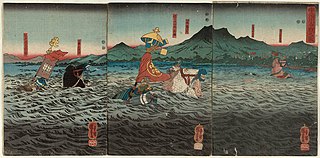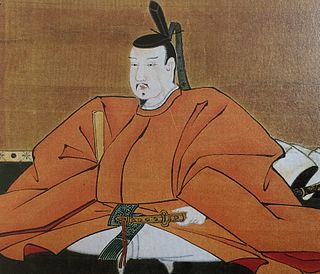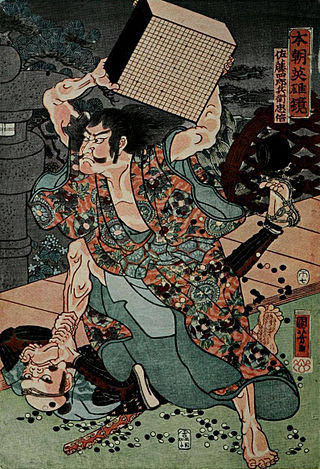
Minamoto no Yoritomo was the founder and the first shogun of the Kamakura shogunate, ruling from 1192 until 1199, also the first ruling shogun in the history of Japan. He was the husband of Hōjō Masako who acted as regent (shikken) after his death.

Minamoto no Yoshinaka, also known as Kiso Yoshinaka, was a Japanese samurai lord mentioned in the epic poem The Tale of the Heike. A member of the Minamoto clan, he was a cousin and rival of shogun Minamoto no Yoritomo during the Genpei War between the Minamoto and the Taira clans in the late Heian period.

Minamoto no Yoshitomo was the head of the Minamoto clan and a general of the late Heian period of Japanese history. His son Minamoto no Yoritomo became shōgun and founded the Kamakura shogunate, the first shogunate in the history of Japan.

Minamoto no Yoshitsune was a commander of the Minamoto clan of Japan in the late Heian and early Kamakura periods. During the Genpei War, he led a series of battles that toppled the Ise-Heishi branch of the Taira clan, helping his half-brother Yoritomo consolidate power. He is considered one of the greatest and the most popular warriors of his era, and one of the most famous samurai in the history of Japan. Yoshitsune perished after being betrayed by the son of a trusted ally and was labelled as a tragic hero.

The Genpei War was a national civil war between the Taira and Minamoto clans during the late Heian period of Japan. It resulted in the downfall of the Taira and the establishment of the Kamakura shogunate under Minamoto no Yoritomo, who appointed himself as Shōgun in 1192, governing Japan as a military dictator from the eastern city of Kamakura.

The Northern Fujiwara were a Japanese noble family that ruled the Tōhoku region of Japan during the 12th century as their own realm.

Saitō Musashibō Benkei, popularly known by the mononym Benkei, was a Japanese warrior monk (sōhei) who lived in the latter years of the Heian Period (794–1185). Benkei led a varied life, first becoming a monk, then a mountain ascetic, and then a rogue warrior. He later came to respect and serve the famous warrior Minamoto no Yoshitsune, also known as Ushiwakamaru. He is commonly depicted as a man of great strength and loyalty, and a popular subject of Japanese folklore showcased in many ancient and modern literature and productions.

The Battle of Dan-no-ura was a major sea battle of the Genpei War, occurring at Dan-no-ura, in the Shimonoseki Strait off the southern tip of Honshū. On April 25, 1185, the fleet of the Minamoto clan (Genji), led by general Minamoto no Yoshitsune, defeated the fleet of the Taira clan (Heike). The morning rip tide was an advantage for the Taira, but turned to their disadvantage in the afternoon. The young Emperor Antoku was one of those who died among the Taira nobles.

Minamoto no Yoshinaka tried to wrest power from his cousins Yoritomo and Yoshitsune, seeking to take command of the Minamoto clan. To that end, he burned the Hōjūji Palace, and kidnapped Emperor Go-Shirakawa. However, his cousins Noriyori and Yoshitsune caught up with him soon afterwards, following him across the Bridge over the Uji, New Year's Day, 1184, which Yoshinaka had torn up to impair their crossing.

Minamoto no Noriyori was a Japanese samurai lord of the late Heian period and early Kamakura period, who fought alongside his brothers Minamoto no Yoritomo and Minamoto no Yoshitsune at a number of battles of the Genpei War. He was the sixth son of Minamoto no Yoshitomo.

The Battle of Ichi-no-Tani was fought between the offensive Minamoto clan and the defensive Taira clan at Suma, to the west of present-day Kobe, Japan, on 20 March 1184. It sat on a very narrow strip of shore, between mountains on the north, and the sea to the south. This made it quite defensible, but also made it difficult to maneuver troops inside the fortress. The Taira suffered a crucial defeat to the forces of Minamoto no Yoshitsune and Minamoto no Noriyori.

Minamoto no Yukiie was the brother of Minamoto no Yoshitomo, and one of the commanders of the Minamoto forces in the Genpei War at the end of the Heian period of Japanese history.

The Men Who Tread on the Tiger's Tail is a 1945 Japanese period drama film written and directed by Akira Kurosawa, based on the kabuki play Kanjinchō, which is in turn based on the Noh play Ataka. It depicts a famous 12th century incident in which Yoshitsune and a small group of samurai cross into enemy territory disguised as monks.

Fujiwara no Hidehira was the third ruler of Northern Fujiwara in Mutsu Province, Japan, the grandson of Fujiwara no Kiyohira. During the Genpei War, he controlled his territory independently of the central government; however, he was the official imperial governor for Mutsu Province as of 1181. He offered shelter to the young Minamoto no Yoshitsune, who had escaped from Kyoto. For many years, Hidehira was Yoshitsune's benefactor and protector, and it was from Hidehira's territory that Yoshitsune joined his brother at the start of the Genpei War.
Fujiwara no Yasuhira was the fourth ruler of Northern Fujiwara in Mutsu Province, Japan, the second son of Hidehira.
Yoshitsune (義経) is a Japanese television drama series originally broadcast between 9 January and 11 December 2005, with a three-part special compilation being aired from 24 December to 25 December 2005. The 44th Taiga Drama, the original work is by Miyao Tomiko, screenplay by Kaneko Narito and starring Hideaki Takizawa.
Taira no Kiyomori (平清盛) is a 2012 Japanese historical television series. It is the 51st NHK taiga drama.

Satō Tadanobu was a Japanese samurai of the late-Heian period. He was a follower of Minamoto no Yoshitsune. According to the Genpei Jōsuiki, he was one of the Yoshitsune Shitennō, along with Kamata Morimasa, Kamata Mitsumasa, and Satō Tsugunobu. He was the younger brother of Tsugunobu, and their father was the Ōshū Fujiwara retainer Satō Motoharu.

Satō Tsugunobu was a Japanese warrior and the brother of Satō Tadanobu. Tsugunobu died in the Battle of Yashima, while protecting Minamoto Yoshitsune from an arrow shot of Taira no Noritsune by riding between Yoshitsune and Noritsune. Tsugunobu was buried in Mure, Kagawa, by Taira no Noritsune.

The Battle of Ōshū was a major battle between the Kamakura government and the Northern Fujiwara that took place in the Tōhoku region of Japan from September 1 to October 14, 1189. It resulted in the downfall of the Northern Fujiwara and the completion of Minamoto no Yoritomo's nationwide domination through the annexation of Mutsu and Dewa Province by the Kamakura shogunate. It was the last battle of the period of civil war known as the Jishō-Juei War that began in 1180, and its end marked the establishment of the first military government, the Kamakura shogunate.

















